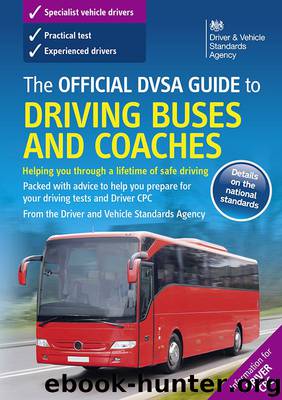The Official DVSA Guide to Driving Buses and Coaches by Driver & Vehicle Standards Agency

Author:Driver & Vehicle Standards Agency
Language: eng
Format: epub
Publisher: Driver & Vehicle Standards Agency
Published: 2015-04-16T00:00:00+00:00
Don’t take your attention off the road ahead for any longer than is absolutely necessary.
Other road users
Others on the road might make mistakes. You have to accept that other road users aren’t always aware of the extra room or time you need, due to the size of your vehicle.
Young children
Young children are particularly unpredictable and might run out into the road suddenly. If you’re passing pedestrians who are walking on the pavement but close to the kerb, you must be aware that the size of your vehicle could cause a draught. This could unsteady a small child or, indeed, an adult. Always check your nearside mirror as you pass.
When in school areas, you may see a pole with two flashing amber lights, one above the other. This means children will be crossing the road to or from school. Slow down and watch out for them.
Older people
Some older pedestrians may have poor eyesight or hearing difficulties. This might make them indecisive and they may sometimes become confused. They also might take longer to cross the road. You need to understand this and allow them more time.
Older drivers might be hesitant or become confused at major junctions or gyratory systems. Don’t intimidate them by driving up too close or revving the engine.
Learner drivers
Learner drivers who aren’t used to all driving situations and other types of road user might be affected by a close-following bus or coach. They might be driving at an excessively low speed or be hesitant. Be patient and give them room.
Cyclists
As you pass a cyclist you should allow them plenty of room – at least the width of a car. They might swerve to avoid a drain cover or a steep camber in the road. If they’re approaching a junction or roundabout, you must be aware that they might turn right from the left-hand lane, crossing the path of traffic. It’s essential that you’re aware of the presence of cyclists all around you. Use your nearside mirror as you pass a cyclist to ensure that you’ve done so safely.
When you’re waiting at a junction, be aware that cyclists might move up along either side. If they’re positioned in front of your nearside mirror, between the kerb and your front nearside wheel, they may be difficult to see. You should be aware of this situation as it develops and allow them to move away before you move off.
Motorcyclists
Much of what has been said about cyclists also applies to motorcyclists. They’re very vulnerable because, like cyclists, they’re much smaller than other vehicles, with a narrow profile, so they’re difficult to see. However, they also travel much faster than cyclists, so any situation develops much more quickly.
Many incidents occur because drivers fail to notice motorcyclists, so look out for them when
emerging at junctions – the motorcyclist may be travelling along the major road and may be hidden behind other traffic. They can be completely hidden from you in the blind spots caused by the vehicle’s door pillars, mirrors, etc. They may also be hidden by signs, trees, or street furniture.
Download
This site does not store any files on its server. We only index and link to content provided by other sites. Please contact the content providers to delete copyright contents if any and email us, we'll remove relevant links or contents immediately.
| Buyers' Guides | Classic Cars |
| Customize | Driver's Education |
| Electric & Hybrid | Foreign |
| History | Industry |
| Insurance | Luxury |
| Motorcycles | Pictorial |
| Racing | Repair & Maintenance |
| Trucks & Vans |
Machine Learning at Scale with H2O by Gregory Keys | David Whiting(4179)
Never by Ken Follett(3790)
Urban Outlaw by Magnus Walker(3340)
OPNsense Beginner to Professional by Julio Cesar Bueno de Camargo(3251)
Sapiens and Homo Deus by Yuval Noah Harari(2987)
Will by Will Smith(2792)
A Short History of Nearly Everything by Bryson Bill(2629)
Hooked: A Dark, Contemporary Romance (Never After Series) by Emily McIntire(2500)
Rationality by Steven Pinker(2291)
Borders by unknow(2227)
The Becoming by Nora Roberts(2087)
Holy Bible (NIV) by Zondervan(2086)
The One Percenter Encyclopedia by Bill Hayes(1787)
HBR's 10 Must Reads 2022 by Harvard Business Review(1776)
Freedom by Sonny Barger(1771)
A Short History of War by Jeremy Black(1762)
Five Ways to Fall by K.A. Tucker(1700)
Go Tell the Bees That I Am Gone by Diana Gabaldon(1687)
Girls Auto Clinic Glove Box Guide by Patrice Banks(1684)
